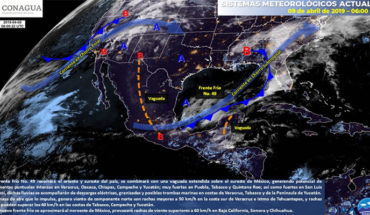But this subcontinent that often wastes opportunities now ends the same decade marked by a growing climate of disappointment and even protests and social outbursts in some countries.
Latin America is now lagging behind other regions in different indicators, from those that measure production to those that assess educational quality.
Ambiguous signs emerged in certain areas in these years.
For example, in the fight against corruption, there were investigations that stripped illegals of businessmen and politicians, including presidents or former presidents in several countries, such as the Odebrecht mega-scandal.
But there were also suspicions of abuses by some judges and prosecutors fighting these crimes, Guatemala’s president closed an International Commission against Impunity (UN-backed CICIG), considered a model for the region, and in countries dominate the idea that corruption in government worsens.
In other issues such as those listed below, there were clear setbacks in Latin America between 2010 and 2019, but there was also progress.
Recoil 1: Economy
The Latin American economy seemed to accelerate with a Formula One engine in 2010, with an expansion of 5.8%. But now the decade ends at skateboard speed.
The average growth rate of regional economies this year will be 0.1%, according to projections from the Economic Commission for Latin America and the Caribbean (Cepal) reported this month.
“If this scenario continued, Sept 2014-2020 would be the lowest economic growth in the region over the past 40 years,” Cepal said in a report.
The Latin American economy could perform worst in four decades. It also saw declines in consumption and GDP per capita, a sustained loss in employment quality and an increase in the regional unemployment rate: it reached 8.2% on average this year.
This means that there would currently be 25.2 million Latin Americans looking for work.
How is it possible that the region has gone from that bonanza that dazzled the world into today’s bleak landscape?
Analysts point to a number of reasons, since the fall in commodity prices whose Boom boosted Latin American exports in the past decade, to problems of public spending efficiency and competitiveness.
There are about 25 million Latin Americans looking for work, according to Cepal.” The region is paying the bill for the global crisis of the last decade, the end of the great commodity cycle, and it’s impressive how there is no government in Latin America that manages to offer a way out,” said Mauricio Santoro, a political scientist at the State University Rio de Janeiro.
“It gives the impression that many times in Latin America we are waiting for the next global cycle of raw materials, the prosperity that will fall on us, but for all the people in the region who are struggling that wait does not work,” he added in dialogue with the BBC World.
Recoil 2: Poverty
Latin America is an old factory of the poor, although that also seemed to change at the beginning of the decade with figures showing poverty reduction.
However, from 2015 ones that encouraging trend was reversed with the end of the economic boom and the difficulties of governments in funding social programs.
Extreme poverty has grown in recent years in America Latina.La poverty rate in Latin America rose from 28% of the population in 2014 to 31% this year, according to Cepal estimates.
This would mean that there are 27 million more poor people and the gains of the early decade vanished, although the rate remains well below 45% in 2002.
But the deterioration was even greater if only people living in extreme poverty are counted, i.e. without access to basic necessities such as food or shelter: they reached 11.5% of the population this year, more than two points above 2008 levels.
In fact, of the total number of poor people that Latin America added in the last year, 26 million would suffer from extreme poverty.
Extreme Poverty in Latin America
In millions of people
Source: Cepal
These figures are largely attributed to the historic recession that Brazil’s largest regional economy has experienced in recent years and Venezuela’s fierce economic crisis.
In the rest of the region, poverty reduction has slowed.
“Our continent has to deal with some structural dramas like inequality and poverty, which are recurring: we remain the most unequal continent, which has the same poverty structures as 200 years ago,” said the secretary-general of the Organization of American States (OAS), Luis Almagro, last month in an interview with BBC Mundo.
Recoil 3: Violence
In addition to being the most unequal region in the world, Latin America is the most violent and has consolidated as such in the last decade.
In the Americas, 37% of the planet’s killings occur, a UN report in July indicated. Almost all are committed in Latin America, where only 8% of the world’s population lives.
Forensics working on public roads: a daily scene in some areas of Latin America.The murder in Latin America “can be described as an epidemic,” said Angela Me, head of investigation of the UN Office on Drugs and Crime (Unodc for its the study, to BBC Mundo.
According to this data, America is the only region in the world where the homicide rate grew compared to 1990, even though it had declined in the past decade.
In 2010 the Americas recorded 15.7 homicides per 100,000 inhabitants and in 2017 (last year of measurement) the figure climbed to 17.2.
In Central America alone, the rate reached 25.9 and in South America at 24.2, four times higher than globally.
Easy access to firearms contributes to Latin America’s bloodbath.Mexico recorded the highest number of murders last year (33,743) since it had an official record in 1997. And by the end of 2019 it comes close to that record, and it could even happen.
Experts attribute so much regional violence to factors such as organized crime and gangs, drug trafficking, ease of access to firearms, impunity and socio-economic conditions in which much of young people grow up.
Advancement: Female prominence
Women gained prominence in Latin America over the past decade, both in political and educational participation and in social mobilizations.
In fact, it is considered one of the regions that made the most progress in gender equality in the world, although it is estimated that it will take several decades to reach full parity at the current rate of change.
Latin American access to higher education increased in such a way that it is estimated that there are now more women than men in universities.
Women’s protests in Latin America inspired feminists in other regions of the world. In politics, at one point in 2014 the region had for the first time four women presidents simultaneously: Cristina Fernández de Kirchner in Argentina, Dilma Rousseff in Brazil, Michelle Bachelet in Chile and Laura Chinchilla in Costa Rica.
At the end of 2017, Latin America again ran out of elected presidents. Today the only woman who heads a government is Jeanine Añez in Bolivia, although she does so on an interim rule.
However, there are eight vice presidents in the region.
And based on laws requiring gender and parity quotas, Latin America is at the forefront of women in parliaments, following a gradual increase in recent years: in 2018 it became the first region to reach an average of 30% , according to the Inter-Parliamentary Union.
Guide
This is still insufficient if women are considered to be about half of the regional population.
And in the business world, for example, very few female executives make the boards of latin American biggest companies.
But changes in the political, university and labor spheres, where the rate of female participation in Latin America has also grown, stand out in a region characterized by its macho culture.
In addition, Latin American women have mobilized in several countries to claim their rights and end the gender-based violence they have suffered since historical times.
The region’s unprecedented street demonstrations of women and their chants from the feminist anthem “A Rapist in Your Path” have inspired similar causes in other parts of the world.
“When you talk about progress, they are relative, but it does mean that we are better than before and that we have a little more legal instruments above all,” Alejandra Mora, executive secretary of the Inter-American Women’s Commission, told BBC Mundo.
“The great advance in the region,” he added, “is to have a normative development that allows it to make awareness of rights that were not established in this way and to demand them from the state.”





